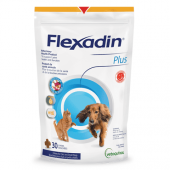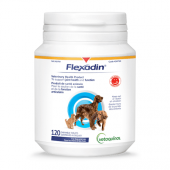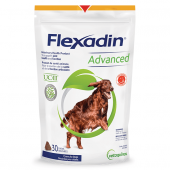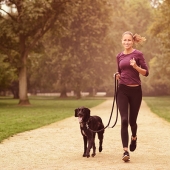When it’s cold, dark and wet outside, going for a walk may sound less tempting than staying in, having a snack and watching “just one more episode”. But just like their owners, dogs who are less physically active during the winter months are at risk of putting on weight. Since it can be harder to lose weight than to prevent weight gain, here’s how you can help your dog stay healthy and fit.
Contact your veterinary clinic first
If you’re concerned about your dog’s weight, contact your veterinary clinic first. They may ask you to bring your dog in for a body condition scoring exam or instruct you to weigh your pet at home. Knowing where your dog stands compared to their ideal weight is important to figure out whether they need to lose some (by increasing physical activity, lowering calorie intake, or both), or simply maintain it.
Calories consumed vs. calories burned
People often put on a few pounds during the winter because the holidays create a habit of eating large and hearty meals, while the cold temperature and the hassle of dressing up appropriately make it more challenging to stay physically active. For dog owners, these habits’ negative consequences can extend to their furry friend. Managing your dog’s weight is about balancing the amount of food they eat and how many calories they burn each day. If they eat more calories than they burn off, either because they eat more or exercise less, the excess intake will turn into added weight.
Keeping your dog active during winter
Regular physical activity is a key part of managing your dog’s weight while keeping them stimulated and entertained. In winter, the cold temperature and short days bring additional challenges that impact the ability to exercise. Take shorter but more frequent daily walks with your dog, and make sure you’re both dressed appropriately. If you’re working from home, take advantage of your flexible schedule to walk your dog in the middle of day, when the sun is warmer and brighter.
To vary the routine, consider simple winter activities you can enjoy as a family alongside your dog. While you’re building a snowman or a snow fort, it’s easy to throw a Frisbee or stick and play fetch with your four-legged friend. If the temperature is mild enough, bring your dog along on a short snowshoeing or cross-country skiing expedition to a nearby park or forest.
Cut down your dog’s caloric intake
If increasing your dog’s activity level is proving difficult, the alternative is to reduce the number of calories they consume. Don’t feed your dog table scraps (this is always healthy advice, regardless of their weight) and cut down on treats. Ask your veterinary clinic for guidance before making more serious diet changes that require careful monitoring. Your clinic may recommend slightly reducing the quantity of food you serve your dog each a day, or to slowly transition them to a specially formulated, low-calorie formula.






